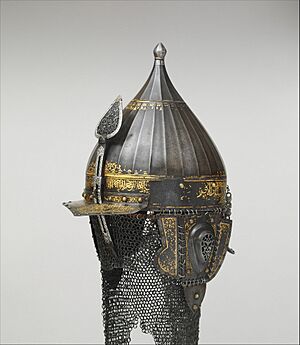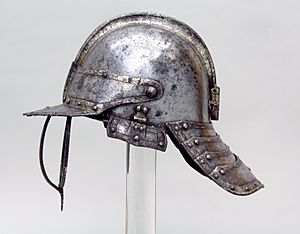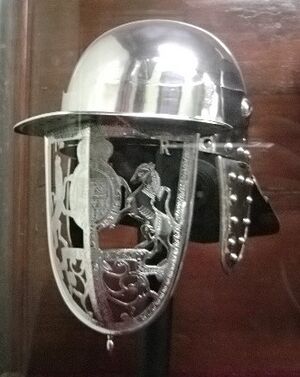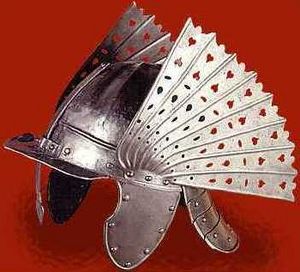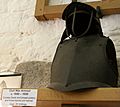Lobster-tailed pot helmet facts for kids
The lobster-tailed pot helmet was a special type of combat helmet that looked a bit like a lobster's tail. It was also known as the zischägge. This helmet became very popular in Europe, especially for cavalry (soldiers who fought on horseback) and their officers, starting around the year 1600. It actually came from a helmet used in the Ottoman Empire. While most of Europe stopped using this helmet by the late 1600s, some Austrian soldiers kept wearing it for battles as late as the 1780s!
Contents
Where Did the Helmet Come From?
The lobster-tailed pot helmet has an interesting history, starting in the East. It came from a helmet called the çiçak (pronounced 'chichak') used by the Ottoman Turks in the 1500s. European countries started using this design in the early 1600s.
The Turkish chichak helmet was very similar to the European versions. It had a peak sticking out at the front, a sliding bar to protect the nose, pieces to cover the cheeks, and a guard for the neck. The main difference was that the Turkish helmets often had a more pointed, conical top instead of a rounded one. When Europeans adopted this helmet, it became widely used during the Thirty Years War. In Germany, it was known as the zischägge, which was a German version of the original Turkish name.
What Did the Helmet Look Like?
The lobster-tailed pot helmet had a rounded top part, called the skull-piece. Sometimes, this part had decorative grooves. Helmets made in England usually had their skull-piece made from two parts joined by a raised line down the middle. Helmets made in other parts of Europe were often made from a single piece of metal.
The helmet also had pieces to protect the cheeks. These were usually one solid piece, but sometimes they could move. They were attached to the helmet with leather straps, though better quality helmets had hinges. To protect the face, there were two main designs:
- A fixed peak at the front with a sliding bar for the nose, held in place by a large screw.
- A peak that could hinge up, with three bars attached to it.
Finally, the helmet had a special guard at the back to protect the neck and the back of the head. This guard was made of several overlapping metal plates, or sometimes a single plate shaped to look like many. This part reminded people of a lobster's tail, which is how the helmet got its name!
Another common name for this helmet was the "harquebusier's pot." A harquebusier was a common type of cavalry soldier in Western Europe during the 1600s. Helmets with a single sliding nose bar were more common in mainland Europe. Helmets with three bars and a peak that could pivot were more popular in Britain. Many European-made helmets were even brought to Britain during the English Civil War.
General George Monck mentioned in 1644 that the "headpiece with three small bars" was strong enough to stop a pistol bullet.
Decorations and Appearance
The look of lobster-tailed pot helmets varied a lot. Some were very fancy and decorated, made for important commanders. Others were simple and mass-produced for many ordinary cavalry soldiers.
High-quality helmets could be decorated in many ways, like with raised designs, engravings, or blue and gold finishes. For example, a helmet made for King James II of England had its three face bars replaced by a metal plate with the royal coat-of-arms carved into it. You could still see through the spaces in the design!
Many helmets were blackened or browned. This treatment helped protect the metal from rust and bad weather. Better quality helmets that were treated this way often had shiny gold rivets to make them look less plain. Some of the most colorful helmets were made for the Polish winged hussars. These often had metal crests and large, fancy nose guards. Some helmets also had tubes to hold feathers, showing that plumes were sometimes worn.
Who Used These Helmets?
This type of helmet was widely used during the Thirty Years War and the English Civil War. In Germany, it was called a zischägge. In Britain, it was known as a 'horseman's pot' or 'three-barred pot'. Today, 'lobster-tailed pot' is a common name used by historians.
A typical cavalry soldier of this time, the harquebusier, would wear this helmet with a buff coat (a strong leather jacket), a gauntlet (a type of glove) on their bridle hand, and a breastplate and backplate (armor for the chest and back). Sometimes, even more heavily armored cavalry, called cuirassiers, wore it with three-quarter armor.
The helmet was used by cavalry on both sides during the English Civil War, including Oliver Cromwell's famous Ironside cavalry. There's a common idea that Cavaliers (supporters of the King) wore fancy hats with feathers, while Roundheads (supporters of Parliament) wore helmets. However, this isn't entirely true! A surviving order signed by King Charles I himself in 1642 asked for 33 'potts' (helmets) and other armor for his own soldiers. Another order from the Parliamentarian side in 1644 asked for 300 "potts with three barres English," and each basic helmet cost 7 shillings.
Similar helmets were worn in the 1600s by Polish winged hussars and were called "szyszak" in Polish, which also came from the original Turkish name. Austrian cuirassiers (heavy cavalry) were still using the lobster-tailed pot helmet as late as the 1780s, long after most other armies had stopped. They used them when fighting against the Ottoman Turks.
Gallery
-
Cuirass and lobster-tailed pot helmet from the English Civil War (1642–1651), displayed at West Gate Towers and Museum, Canterbury, England.
-
Armour of Stephen Báthory (around 1560, who later became King of Poland), displayed at the Kunsthistorisches Museum in Vienna, Austria.
-
Turkish conical helmets from the 15th to early 16th century, displayed at Topkapı Palace, Istanbul, Turkey.
-
Chichak (also called šišak, zischagge or erikhonka) of Nikola Šubić Zrinski (1508-1566), a Ban (Viceroy) of Croatia. This was shown at an exhibition in Čakovec for the 450th anniversary of the battle of Szigetvár.



